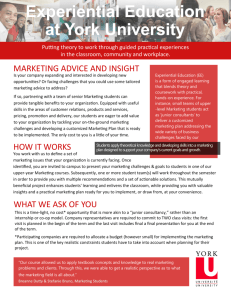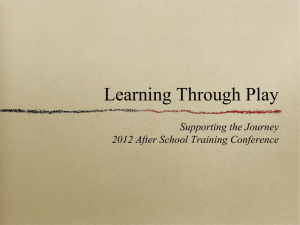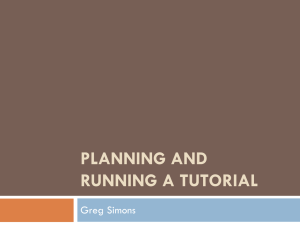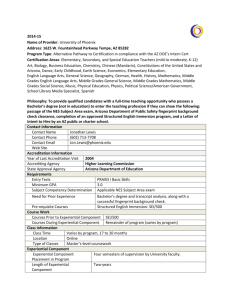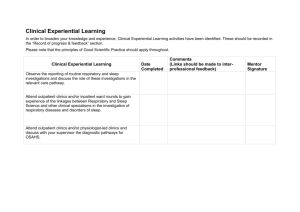Experiental Marketing vs. Traditional Marketing
advertisement
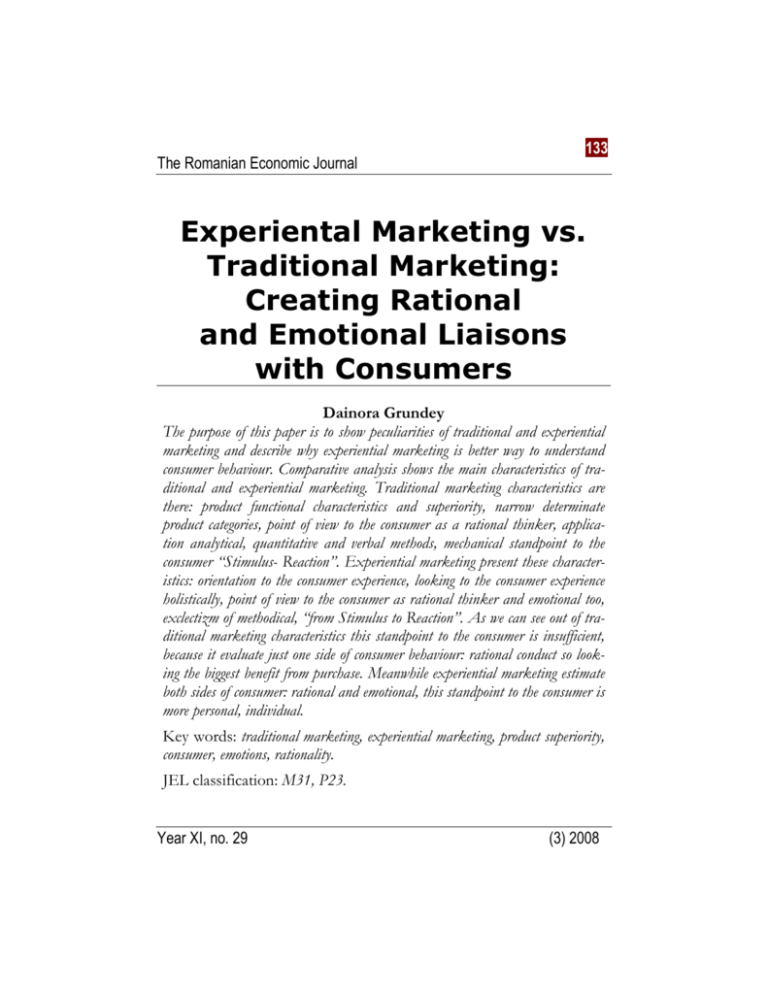
133 The Romanian Economic Journal Experiental Marketing vs. Traditional Marketing: Creating Rational and Emotional Liaisons with Consumers Dainora Grundey The purpose of this paper is to show peculiarities of traditional and experiential marketing and describe why experiential marketing is better way to understand consumer behaviour. Comparative analysis shows the main characteristics of traditional and experiential marketing. Traditional marketing characteristics are there: product functional characteristics and superiority, narrow determinate product categories, point of view to the consumer as a rational thinker, application analytical, quantitative and verbal methods, mechanical standpoint to the consumer “Stimulus- Reaction”. Experiential marketing present these characteristics: orientation to the consumer experience, looking to the consumer experience holistically, point of view to the consumer as rational thinker and emotional too, exclectizm of methodical, “from Stimulus to Reaction”. As we can see out of traditional marketing characteristics this standpoint to the consumer is insufficient, because it evaluate just one side of consumer behaviour: rational conduct so looking the biggest benefit from purchase. Meanwhile experiential marketing estimate both sides of consumer: rational and emotional, this standpoint to the consumer is more personal, individual. Key words: traditional marketing, experiential marketing, product superiority, consumer, emotions, rationality. JEL classification: M31, P23. Year XI, no. 29 (3) 2008 134 The Romanian Economic Journal Introduction Nowadays then the world is very quickly change, coming new technologies, communication, comes changes in to the marketing too. In the Great Britain, USA and similar counties markets are overfill with products and services. There are big competitions so principles and actions of traditional marketing do not work. How attract new consumers, cause? These opportunities have experiential marketing. Some propositions of traditional marketing are discussed. In the traditional marketing commodity is understanding as accomplice of attributes. K. Lancaster expressed this standpoint the first time in 1966. Then this standpoint was developing by F. Kotler, T. Nagle. In the newest science literature we can find good description as a complex of characteristics and superiority. Many consumer behaviour researches such as Kotona, Engel, Blackwell, Minard (1999) consumer estimate like rational thinker. This standpoint is based on concept of information remaking. This concept widely comes from cognityvical psychology. Marketing-mix inventor Neil Borden (1964) asserts that united components in the marketing-mix are not. Marketing-mix theory was criticising due to its mechanical point of view (stimulus- reaction). Now is proved that between stimulus and reaction is process. The notion of experience has entered the field of consumption and marketing through Holbrook and Hirschman’s 1982 pioneering article. Twenty years after, this notion has gained ground to be recognised as important for what it can contribute to marketing knowledge of the consumer. As a consequence, it is the pillar of the socalled experience economy and experiential marketing. Building on Arnould and Price’s well-known 93’s “River Magic” paper on extraordinary experiences, marketers tend to engage consumers in a memorable way, offering them extraordinary experiences. For them, experiences provide consumers a way to engage physically, mentally, emoYear XI, no. 29 (3) 2008 135 The Romanian Economic Journal tionally, socially and spiritually in the consumption of the product or service making the interaction meaningfully real. Empiricism – this is base oneself one experience, sensual perception guarantee reliability (Hollis, 1994). Experiential marketing includes much more than sensual and rational perceptions. In 1982 B. Holbook and E. Hirshman separate only experiential standpoint, but experiential marketing conception still not using. These scientists trying replenish rational consumer understanding with experiential point of view. But only B. Scmitt (2001) totally separately divided traditional and experiential marketing. The main purpose of the paper is two-fold, namely a) to demonstrate the evolution of the notion of experience applied in experiential marketing and b) to show why experiential marketing could be applied in theory and practice rather than traditional marketing. EXPLORING THE NOTION OF ‘EXPERIENCE’ For researchers in consumer behaviour, an experience is above all a personal occurrence, often with important emotional significance, founded on the interaction with stimuli which are the products or services consumed. This occurrence may lead to a transformation of the individual in the experiences defined as extraordinary.1 Taking up the argument of sociology research in consumer behaviour considers experience as a central element of the life of today’s consumer, a consumer who is looking for sense: “for the post-modern consumer, consumption is not a mere act of devouring, destroying, or using things. It is also not the end of the (central) economic cycle, but an act of production of experiences and selves or self-images...”2 1 2 Arnould and Price, 1993 Vezina, 1989, p 62 Year XI, no. 29 (3) 2008 136 The Romanian Economic Journal Life is to be produced and created, in effect, constructed through the multiple experiences in which the consumer implicates. As a consequence, a key concept developed along with experience is the one of immersion: the post-modern consumer is said to take pleasure “in being immersed in McDisneyfied banalities”.1 Indeed, there is the recognition of a “growing quest on the part of the contemporary consumers for immersion into varied experiences” more and more conceptualized as “embodied experiences”. The roots of this so-called experiential consumption must be sought in the growth of services, for which the good that is purchased is an experience rather than a material object. Its main feature is to grant space to emotions. This leads to an experiential approach to the study of consumption which recognises the importance of variables that have previously been neglected: “the roles of emotions in behaviour; the fact that consumers are feelers as well as thinkers and doers; the significance of symbolism in consumption; the consumer’s need for fun and pleasure; the roles of consumers, beyond the act of purchase, in product usage as well as brand choice, and so forth”.2 In the experiential perspective, the consumption experience is no longer limited to some prepurchase activity, nor to some postpurchase activity, e.g. the assessment of satisfaction, but includes a series of other activities which influence consumers’ decisions and future actions. Consumption experience is thus spread over a period of time which, according to Arnould and Price (1993), can be divided into four major stages: • The pre-consumption experience, which involves searching for, planning, day-dreaming about, foreseeing or imagining the experience; • The purchase experience which derives from choice, payment, packaging, the encounter with the service and the environment; 1 2 Thompson, 2000 Addis and Holbrook, 2001, p. 50 Year XI, no. 29 (3) 2008 137 The Romanian Economic Journal • The core consumption experience including the sensation, the satiety, the satisfaction/dissatisfaction, the irritation/flow, the transformation; • The remembered consumption experience and the nostalgia experience activates photographs to re-live a past experience, which is based on accounts of stories and on arguments with friends about the past, and which moves towards the classification of memories. Thus, the consumption experience cannot be reduced to the sole shopping experience, e.g. the experience at the point of sale. This concept of shopping experience is based on work which since the 1970’s has looked at purchasing behaviour at the point of sale and sought to go beyond the hypothesis of consumer rationality. This first revealed a type of consumer termed ‘recreative’. Later, broader studies highlighted hedonistic behaviour in most consumers, so moving attention from the utilitarian to the hedonistic value of shopping. For marketing, design and economy, an experience is mainly a type of offering to be added to merchandise, products and services to give a fourth type of offering which is particularly suited to the needs of the postmodern consumer. Indeed, there is a shared belief among these authors that the post-modern or “millennial consumer” is simply not what the rational model of marketing wanted her/him to be. Thus, for marketing, as Gupta and Vajis state, a good experience is ‘memorable’, if not ‘extraordinary’, allowing this consumer to exploit all his/her senses through the staging of the activity/physical support/social interaction triptych. This type of experience produces emotions (in marketing, emotional experience or emotion is often cited as the heart of the consumption experience) and also transformations in individuals. “Some industry experts argue that economic value now turns on more than a high-quality product or good service delivery: it turns on engaging customers in a memorable way offering them an experience, or even better, transforming them by guiding them through experiences. When offering experiences marketers are conYear XI, no. 29 (3) 2008 138 The Romanian Economic Journal cerned with staging the experience – making it memorable and personal”.1 Experience, in this paper, is defined as a subjective episode in the construction/transformation of the individual, with however, an emphasis on the emotions and senses lived during the immersion at the expense of the cognitive dimension. Marketing, on the other hand, gives experience a much more objective (rather than subjective) meaning, confirming the idea that the result may must be something extremely significant and unforgettable for the consumer immerged into the experience. Despite the existence of different experience typologies, it is the flow experience with its idea of total immersion or plunge which has most attracted marketing researchers, in particular those working on consumer behaviour, who, as Arnould and Price state, have compared it to the peak experience conceptualised by Maslow in the 1960’s with reference to religious ecstasy. The experience has also been compared to the epiphanic experience described by Denzin and to the extraordinary experience introduced by Abrahams. For Denzin , “epiphanic experiences rupture routines and lives and provoke radical redefinitions of the self. In moments of epiphany, people redefine themselves”.2 SHMITT’S APPROACH EXPERIENCE TO THE NOTION OF It is very important to analyze Shmitt’s (he is the great initiator of experiential marketing) attitude to experiences. In particular, Schmitt takes issue with the features and benefits approach of traditional marketing. In this (traditional) model, consumers are thought to go through a considered decision-making process, where each of the features or characteristics of a particular product or service are seen to 1 2 Arnould., 2002, p. 423 Denzin, 1992, p.26 Year XI, no. 29 (3) 2008 139 The Romanian Economic Journal convey certain benefits, and these are all assessed by the potential purchaser (either consciously or unconsciously). However, for Schmitt, this is far too limited a way of viewing the purchase decision, with excessive emphasis on the rational and logical elements of the decision, and not enough (or any) on the emotional and irrational aspects involved in the purchase. The alternative framework that Schmitt proposes is based upon two elements: strategic experience modules (which he calls SEMs), which are different types of experiences, and ExPros (short for experience producers) which are the various agencies that deliver these experiences. Experience marketing is the discipline of creating products and services that consider all elements of this framework. Schmitt identifies five different types of experiences or ‘strategic experience modules’ (SEMs). These are: SENSE: These are sensual and tangible aspects of a product or experience that appeal to the five senses of sight, sound, scent, taste and touch. Sense experiences are particularly useful to differentiate products or services, to motivate potential customers, and to create a sense of value in the mind of the purchaser. FEEL: Feel marketing is devoted to inducing affect (i.e. the creation of moods and emotions) that adhere to the company and brand. Clearly, positive or negative feelings toward a product or service will influence the extent to which it is consumed. THINK: The objective of think marketing is to encourage customers to engage in elaborative and creative thinking that may result in a reevaluation of the company and products. ACT: Act marketing is oriented towards the creation of experiences through behavior on the part of the customer, either privately or in the company of others. The goal is to change long-term behavior and habits in favour of the particular product or service. Year XI, no. 29 (3) 2008 140 The Romanian Economic Journal RELATE: Relate marketing expands beyond the individual's private sensations, feelings, cognitions and actions by relating the individual self to the broader social and cultural context reflected in a brand. In other words, relate marketing plays upon the identification of self with the context and associations bound up in the product or service used. These five different types of experiences (SEMs) are conveyed to individuals through experience providers (ExPros), which are vehicles such as: 1. Communications: advertising, external and internal company communications, public relations campaigns visual and verbal identity and signage, including names, logos, colours, etc. 2. Product presence: design, packaging, and display 3. Co-branding: involving event marketing, sponsorships, alliances and partnerships, licensing, product placement in movies, etc. 4. Spatial environments: which include the external and internal design of corporate offices, sales outlets, consumer and trade fair spaces, etc. 5. Web sites. 6. People: salespeople, company reps, customer service providers, call centre operators. Year XI, no. 29 (3) 2008 141 The Romanian Economic Journal Figure 1. Shmitt’s Experiential Grid Source: www.exmarketing.com, referred on 26/03/2008. Interaction of SEMs with ExPros generates what Schmitt calls the ‘Experiential Grid’: a comprehensive framework for considering all the ways in which experiences can be induced on the part of an actual or potential customer. The first two sections of the book are devoted to an elaboration of the underpinnings of this framework, which is conceptually illustrated in Figure 1. Traditional VS. Experiential Marketing: comparative analysis When we talk about experiential marketing superiority against traditional marketing, it’s only theoretical preposition. But why experiential marketing is better then traditional marketing and what revolutionising experiential marketing doing that we have better opportunity in the best way to understand consumer behaviour. This problem may help Year XI, no. 29 (3) 2008 142 The Romanian Economic Journal decide comparative analysis between traditional and experiential marketing. In this analysis we will see disadvantages of traditional marketing. Traditional Marketing Defined Bernard Schmitt (2001) like this describes traditional marketing: there are complex of principles, conceptions and methodology, working off by scientists, consults and marketing practices (Schmitt, 2001). In the traditional marketing principles and conceptions talking about product and its nature, consumer behaviour and competition wars. These things are using to new products creation, planning sales assortment and brands, projecting communication with consumer and doing returning actions to the competitors. Traditional marketing and its four main characteristics that it is have by Bernard Schmitt (Figure 2). Functional characteristics and superiority: Traditional marketing is orientated to the commodity functional characteristics and superiority. In the any market clients look some characteristics of the goods that have the biggest benefit for them. F. Kotler (1969) talking about goods characteristics emphasise that “characteristics add traditional goods function”. In the traditional marketing, marketing specialist have to know, that consumer interested no good as itself, but it’s characteristics, that have each of it. The first time this standpoint was expressing by Lancaster in 1966. He talks about products attributes, so individuals have different reaction to the same good because they gives preference to the good attributes. Year XI, no. 29 (3) 2008 143 The Romanian Economic Journal Figure 2. Peculiarities of Traditional Marketing Traditional Marketing Functional Characteristics Narrow determinate categories product and Consumer as a rational thinker accepting decision Analytical, quantitative and verbal methods Source: Schmitt (2001). If we think that consumer choose product according to its characteristics therefore we differentiate products according to its characteristics too. Superiority appears from products functional characteristics. Superiority – this is consumption characteristics what wants consumer then he buys a product. Bernard Scmitt (2001) asks, does the good is only characteristics and superiority? (Scmitt, 2001). We have opportunity to answer the question, only if we would like to consumer from both sides: rational and emotional. Narrow determinate product categories and surrounding competitor limits: Traditional marketing looks narrow to the surrounding competitors and to the products too. Traditional marketing separated concrete goods and services. For example if we want separate Chinese restaurants as our competitors we turn one’s attention to other Chinese restaurants. But Year XI, no. 29 (3) 2008 144 The Romanian Economic Journal we may name all surrounding restaurants and bars, pubs, in generally all public-feeding institutions. Consumers want not only to eat or to have some benefit but also to get sense, feelings; they want to enjoy with internal atmosphere. Consumer as a rational thinker accepting decision: Marketing and economic specialists value consumer purchase process like rational decision looking then consumer only wants to solve a problem. J. Engel, R. Blackwell and P. Miniard (1999) separate seven consumer purchase process stages (Engel, Blackwell, Miniard, 1999): 1. Problem. 2. Search of information. 3. Estimation of versions. 4. Purchase. 5. Consumption. 6. Estimation of versions after purchase. 7. Release of the problem. Traditional marketing says that consumer controls the situation and purchase is sensible action. This action consumer does then he wants to solve a problem. Using analytical, quantitative and verbal methods: Traditional marketing is using analytical, quantitative and verbal methods. And instruments are using too to the making research. In the traditional marketing all marketing- mix is orientated to the consumer, believing results according to this principle: “Stimulus- Reaction” (Van Vaterschoot, 2002). This standpoint is the biggest marketing-mix disadvantages, because this point of view is very limited, in the other worlds it is mechanical. We do not estimate other factors such as individuality of consumer, emotions, feelings and other. Year XI, no. 29 (3) 2008 145 The Romanian Economic Journal Experiential Marketing Defined In our days consumer perceive goods characteristics and superiority, quality of good, positive brand image as them goes without saying. So this thins does not work, consumer is waiting such product, communication or company which wake his feelings, agitate his soul and mind. He wants such products, advertising and company, which will be orientated to him and corresponds his life style. Consumer wants that all these things raise experience (Scmitt, 2001). Paul Postma looking over new marketing era related to the new technology, said that is going changes in the obtaining information about consumer, information rendering to the consumer- appears new technologies, new advertising opportunities. But technology and its new era does not work to the person and his behaviour (Postma, 1999). The author said that some methods we can change, but personal needs always are very important. People have inclinations and specific features, and these things do not change all over century. Experiential marketing has also four characteristics by Bernard Scmitt (Figure 3). Figure 3. Characteristics of Experiential Marketing Client experiens Experiential Marketing Consumer like a holistically experiens Consumer as arational thinker and emotional “animal” Methodic exclectizm Source: Scmitt (2001) Year XI, no. 29 (3) 2008 146 The Romanian Economic Journal Client experience: At different from traditional marketing in the experiential marketing the main accent is client experience, which appearance when client benevolent or by force is in the determinate situation. Experience this is result of soul, mind and stimulation to the sense. Experience shows sensitive, emotional cognitive characteristics of the behaviour, characters, standpoints, and values, which are equalised with functional values. Consumer like a holistically experience: In the traditional marketing we saw narrow determinate products and competitors; experiential marketing does not have personal categories for example shampoo, cream. Instead of we state “body and hair care in the bathroom”. Then we decide that products are in this using situation. Acceding products, its packing, advertising can awaken wish to experience those product using. Consumer situation analysis and selecting more general product categories and competitors in the some frames allow understanding other possibilities in the market. Consumer as a rational thinker and emotional “animal”: Consumer behaviour influence rational factors but emotional too. So consumer chooses his purchase following rational causes and his fantasies, feelings. Person is waiting that somebody stimulates him/her, agitate his feelings. Therefore, the traditional point of view is insufficient. Methodical eclecticism: In the experiential marketing we have possibility to use many research methods. There is no one a methodological model and in its own research this marketing is eclectically. In the newest marketing theories we can see process between Stimulus and Reaction. This process is represented in Figure 4. Year XI, no. 29 (3) 2008 147 The Romanian Economic Journal Figure 4. From Stimulus to Reaction Stimulus Standpoints, Feelings Brain Watch Action Source: Postma (1999) Information assignment means make Stimulus which accept feelings and then assignment to the brain where is all points of view about reality. Coming impressions is changing by the brain and then formatted reception which help to reach some action (Postma, 1999). Psychological standpoint: G. Foall (2002) analysing relation between marketing and psychology almost combine traditional and experiential marketing. He notes that talking about consumer behaviour is very important sensations before purchase, in purchase time and in using process (Foxall, 2002). But in this theory goods characteristic is very important too. Year XI, no. 29 (3) 2008 148 The Romanian Economic Journal Results In the result chapter we describe two marketing paradigms. The main differences of two marketing paradigm shown in Figure 4 - traditional vs. experiential. In Figure 5 we saw that traditional marketing have the main ascent to the facts. So it have “engineering”, rational, analytical point of view to the consumer, commodity and competitor. This standpoint does not have psychological base, which help us to understand consumer condition, his reaction to product and our surrounding competitors. If we think that consumer rational thinker we accept an opportunity that consumer running from one store to the other and looking better variant. But this description is not the best and the only because we saw one side of consumer behaviour. However a lot of researchers recognise that consumer is a living person with hi/her empirical experience: he/she wants that somebody stimulate, entertain he. So we have different point of view to the consumer commodity and surrounding competitors. Figure 5. Proposed differences of traditional vs. experiential marketing paradigms TRADITIONAL MARKETING Characteristics and superiority Mechanical point of view to the consumer “Stimulus-Reaction” Different understanding consumer and commodity Year XI, no. 29 EXPERIENTIAL MARKETING Sensual, emotional, cognityvic, fealing, acts and standpoints “From Stimulus to Reaction” (3) 2008 149 The Romanian Economic Journal CONCLUSIONS This paper shows two marketing paradigms, which let to understand different standpoints to the consumer. Traditional marketing presents consumer like a rational thinker who won’t the biggest benefit from his purchase this consumer run all seven purchase stages. The more commodity is complicated the much more consumer is looking for the biggest benefit to him. Consumer notices goods and theirs characteristics, superiority comparative to other goods. If we do some step to introduce good to the consumer and use other marketing-mix elements we have a big success (Stimulus-Reaction). Experiential marketing looks to the consumer like a rational and emotional too. Then consumer buying the good rational and emotional factors is working to him the same powerfully. He can pass off all seven purchase steps, but he can’t and not pass off, if he will be affected his sense, feelings and other experiential things. When we talk about marketing mix and its elements we have to know that behind the stimulus and reaction we have process where consumer thinking. This thing process stands on his feelings, points of view. What kind of revolution we have in economic, technology or marketing always consumer will stay an individual, alive, who want to get to the sense, feel, thing act and relation to your company and brand. REFERENCES Abrahams, R.D. (1986) ‘Ordinary and Extraordinary Experience’, in Turner, V.W. and Bruner, E.M. (eds.) The Anthropology of Experience, pp. 45-73. Urbana, University of Illinois Press. Addis, M. and Holbrook, M. B. (2001) ‘On the Conceptual Link between Mass Customisation and Experiential Consumption: An Explosion of Subjectivity’, Journal of Consumer Behaviour 1(1): 50-66. Year XI, no. 29 (3) 2008 150 The Romanian Economic Journal Arnould, E. and Price, L. (1993) ‘River Magic: Extraordinary Experience and the Extended Service Encounter’, Journal of Consumer Research 20 (June): 24-45. Arnould, E., Price, L. and Zinkhan, G. (2002) Consumers. New York, McGraw-Hill. Blois, K. (1997) ‘When is a Relationship ‘a Relationship’?’, in Gemünden, H.G., Ritter, T. And Walter, A. (eds.) Relationships and Networks in International Markets, pp. 53-64. Borden H. N. (1964). “The Concept of the Marketing Mix”, Journal of Advertising Research, June, pp. 2-7. Codeluppi, V. (2000). Lo spettacolo della merce: I luoghi del consumo dai passages a Disney World. Milano, Bompiani. Engel F. J.; Blackwell D. R. and Miniard W. P. (1999). Consumer Behavior, Eight Edition. New York: The Dryden Press. Holbrook B. M. and Hirshman C. E. (1982). “The Experiential Aspects of Consumption: Consumer Fantasies, Feeling and Fun”, Journal of Consumer Research. Vol.9, September, pp.132-140. Hollis M. (1994). The Philosophy of Social Science. Cambridge, Cambridge University Press. Katona G. (1953). “Rational Behaviour and Economic Behaviour”, Psychological Reviewer. September, pp. 307-318. Kotler P. (2001). Marketing Management: The Millenium Edition. New Jersy: Prentice Hall. Kotler P. and Levy J. S. (1969). “Broadening the Concept of Marketing”, Journal of Marketing, January, pp 10-15. Postma P. (1999). The New Marketing Era: Marketing to the Imagination in a Technology – Drive World. New York: McGrew – Hill. Year XI, no. 29 (3) 2008 151 The Romanian Economic Journal Schmitt, B.H. (1999) Experiential Marketing: How to Get Customers to SENSE, FEEL, THINK, ACT and RELATE to Your Company and Brands. New York, The Free Press. Urbain, J.D. (2002) Les vacances. Paris, Le Cavalier Bleu. Vézina, R. (1999) ‘Pour comprendre et analyser l’expérience du consommateur ‘,Gestion, 24(2) : 59- 65. Ван Ватершут У. (Van Vatershur) (2002). Маркетинг-микс. Теория маркетинга, Санкт-Петербург: Питер, с.304-329. [Marketing Mix, in Russian]. Фоксолл Р. Г. (Foxoll). (2002). Психологические основы маркетинга. Теория маркетинга, Санкт-Петербург: Питер, с.130150. [Psychological fundamentals of marketing, in Russian]. Шмитт Б. (Schmitt) (2001). Емпирический маркетинг. Москва, Фаир-пресс, 2001. [Experiential Marketing, in Russian]. Internet sources (referred on 26/03/2008): www.exgroup.com www.medialiveinernational.com Schmitt, H., Marketers www.exmarketing.com seeking sense in sensibility, Gautier, A., Think Again Why Experiential Marketing is The Next Big Thing, www.marketingmag.co.nz. Hurst, M., Joining Strategy and Usability: the Customer Experience Methodology, www.creativegood.com Dainora GRUNDEY, Professor, Ph. D., Kaunas Faculty of Humanities, Vilnius University, Lithuania. Year XI, no. 29 (3) 2008
